Professional Skills Portfolio (PRSK4048): Spring 18 Self-Reflection
VerifiedAdded on 2023/06/14
|27
|8052
|379
Portfolio
AI Summary
This Professional Skills Portfolio (PRSK4048) from Spring 18 includes various tasks designed to enhance self-awareness and professional skills. It begins with outlining a long-term vision and assessing potential career roles, followed by a Belbin team role self-assessment. The portfolio also covers cross-cultural awareness, meeting participation, action planning, conflict resolution, and ethical awareness. Furthermore, it incorporates a presentation plan, post-presentation reflection, a 360-degree review, and a professional development plan (PDP). The portfolio culminates in two written tasks: 'Professional Skills In Action' and 'Your Professional Skills,' which require applying the learned concepts and reflecting on personal strengths and weaknesses in a professional context. The student reflects on education, living environment, preferred work style, and personal values to craft a future vision. It also assesses suitability for the role of Events Operation Manager.
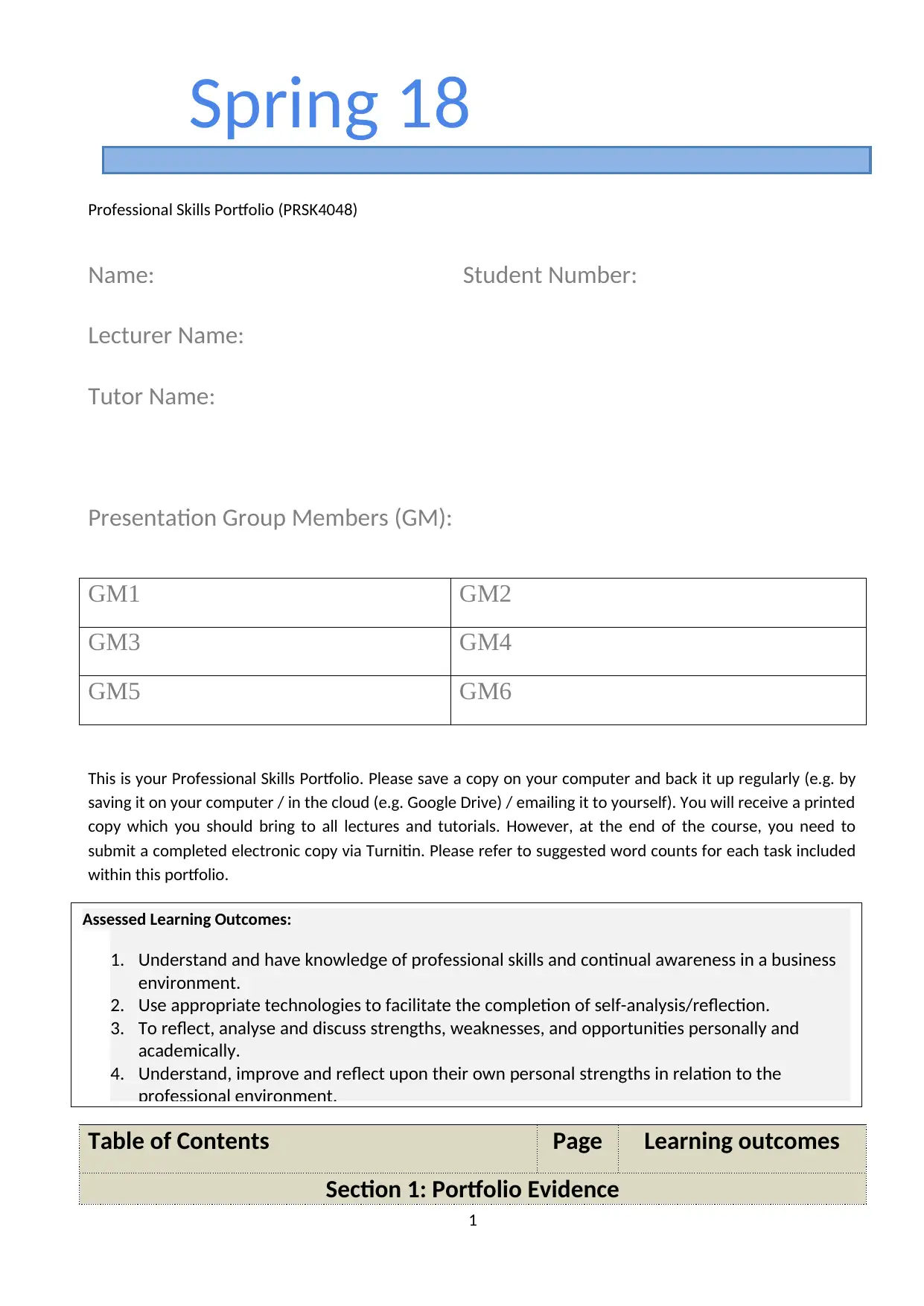
Spring 18
Professional Skills Portfolio (PRSK4048)
Name: Student Number:
Lecturer Name:
Tutor Name:
Presentation Group Members (GM):
GM1 GM2
GM3 GM4
GM5 GM6
This is your Professional Skills Portfolio. Please save a copy on your computer and back it up regularly (e.g. by
saving it on your computer / in the cloud (e.g. Google Drive) / emailing it to yourself). You will receive a printed
copy which you should bring to all lectures and tutorials. However, at the end of the course, you need to
submit a completed electronic copy via Turnitin. Please refer to suggested word counts for each task included
within this portfolio.
Table of Contents Page Learning outcomes
Section 1: Portfolio Evidence
1
Assessed Learning Outcomes:
1. Understand and have knowledge of professional skills and continual awareness in a business
environment.
2. Use appropriate technologies to facilitate the completion of self-analysis/reflection.
3. To reflect, analyse and discuss strengths, weaknesses, and opportunities personally and
academically.
4. Understand, improve and reflect upon their own personal strengths in relation to the
professional environment.
Professional Skills Portfolio (PRSK4048)
Name: Student Number:
Lecturer Name:
Tutor Name:
Presentation Group Members (GM):
GM1 GM2
GM3 GM4
GM5 GM6
This is your Professional Skills Portfolio. Please save a copy on your computer and back it up regularly (e.g. by
saving it on your computer / in the cloud (e.g. Google Drive) / emailing it to yourself). You will receive a printed
copy which you should bring to all lectures and tutorials. However, at the end of the course, you need to
submit a completed electronic copy via Turnitin. Please refer to suggested word counts for each task included
within this portfolio.
Table of Contents Page Learning outcomes
Section 1: Portfolio Evidence
1
Assessed Learning Outcomes:
1. Understand and have knowledge of professional skills and continual awareness in a business
environment.
2. Use appropriate technologies to facilitate the completion of self-analysis/reflection.
3. To reflect, analyse and discuss strengths, weaknesses, and opportunities personally and
academically.
4. Understand, improve and reflect upon their own personal strengths in relation to the
professional environment.
Paraphrase This Document
Need a fresh take? Get an instant paraphrase of this document with our AI Paraphraser
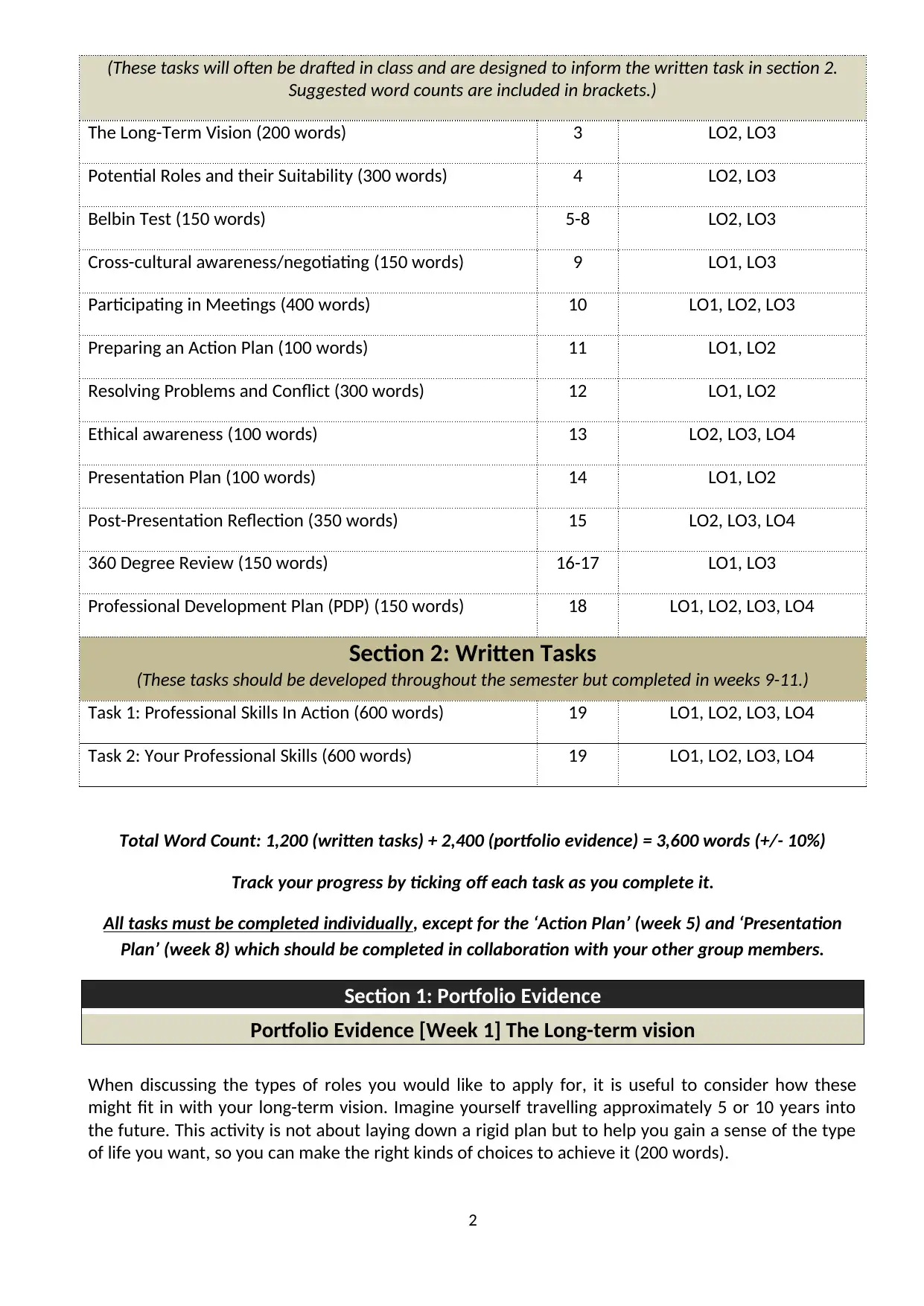
(These tasks will often be drafted in class and are designed to inform the written task in section 2.
Suggested word counts are included in brackets.)
The Long-Term Vision (200 words) 3 LO2, LO3
Potential Roles and their Suitability (300 words) 4 LO2, LO3
Belbin Test (150 words) 5-8 LO2, LO3
Cross-cultural awareness/negotiating (150 words) 9 LO1, LO3
Participating in Meetings (400 words) 10 LO1, LO2, LO3
Preparing an Action Plan (100 words) 11 LO1, LO2
Resolving Problems and Conflict (300 words) 12 LO1, LO2
Ethical awareness (100 words) 13 LO2, LO3, LO4
Presentation Plan (100 words) 14 LO1, LO2
Post-Presentation Reflection (350 words) 15 LO2, LO3, LO4
360 Degree Review (150 words) 16-17 LO1, LO3
Professional Development Plan (PDP) (150 words) 18 LO1, LO2, LO3, LO4
Section 2: Written Tasks
(These tasks should be developed throughout the semester but completed in weeks 9-11.)
Task 1: Professional Skills In Action (600 words) 19 LO1, LO2, LO3, LO4
Task 2: Your Professional Skills (600 words) 19 LO1, LO2, LO3, LO4
Total Word Count: 1,200 (written tasks) + 2,400 (portfolio evidence) = 3,600 words (+/- 10%)
Track your progress by ticking off each task as you complete it.
All tasks must be completed individually, except for the ‘Action Plan’ (week 5) and ‘Presentation
Plan’ (week 8) which should be completed in collaboration with your other group members.
Section 1: Portfolio Evidence
Portfolio Evidence [Week 1] The Long-term vision
When discussing the types of roles you would like to apply for, it is useful to consider how these
might fit in with your long-term vision. Imagine yourself travelling approximately 5 or 10 years into
the future. This activity is not about laying down a rigid plan but to help you gain a sense of the type
of life you want, so you can make the right kinds of choices to achieve it (200 words).
2
Suggested word counts are included in brackets.)
The Long-Term Vision (200 words) 3 LO2, LO3
Potential Roles and their Suitability (300 words) 4 LO2, LO3
Belbin Test (150 words) 5-8 LO2, LO3
Cross-cultural awareness/negotiating (150 words) 9 LO1, LO3
Participating in Meetings (400 words) 10 LO1, LO2, LO3
Preparing an Action Plan (100 words) 11 LO1, LO2
Resolving Problems and Conflict (300 words) 12 LO1, LO2
Ethical awareness (100 words) 13 LO2, LO3, LO4
Presentation Plan (100 words) 14 LO1, LO2
Post-Presentation Reflection (350 words) 15 LO2, LO3, LO4
360 Degree Review (150 words) 16-17 LO1, LO3
Professional Development Plan (PDP) (150 words) 18 LO1, LO2, LO3, LO4
Section 2: Written Tasks
(These tasks should be developed throughout the semester but completed in weeks 9-11.)
Task 1: Professional Skills In Action (600 words) 19 LO1, LO2, LO3, LO4
Task 2: Your Professional Skills (600 words) 19 LO1, LO2, LO3, LO4
Total Word Count: 1,200 (written tasks) + 2,400 (portfolio evidence) = 3,600 words (+/- 10%)
Track your progress by ticking off each task as you complete it.
All tasks must be completed individually, except for the ‘Action Plan’ (week 5) and ‘Presentation
Plan’ (week 8) which should be completed in collaboration with your other group members.
Section 1: Portfolio Evidence
Portfolio Evidence [Week 1] The Long-term vision
When discussing the types of roles you would like to apply for, it is useful to consider how these
might fit in with your long-term vision. Imagine yourself travelling approximately 5 or 10 years into
the future. This activity is not about laying down a rigid plan but to help you gain a sense of the type
of life you want, so you can make the right kinds of choices to achieve it (200 words).
2
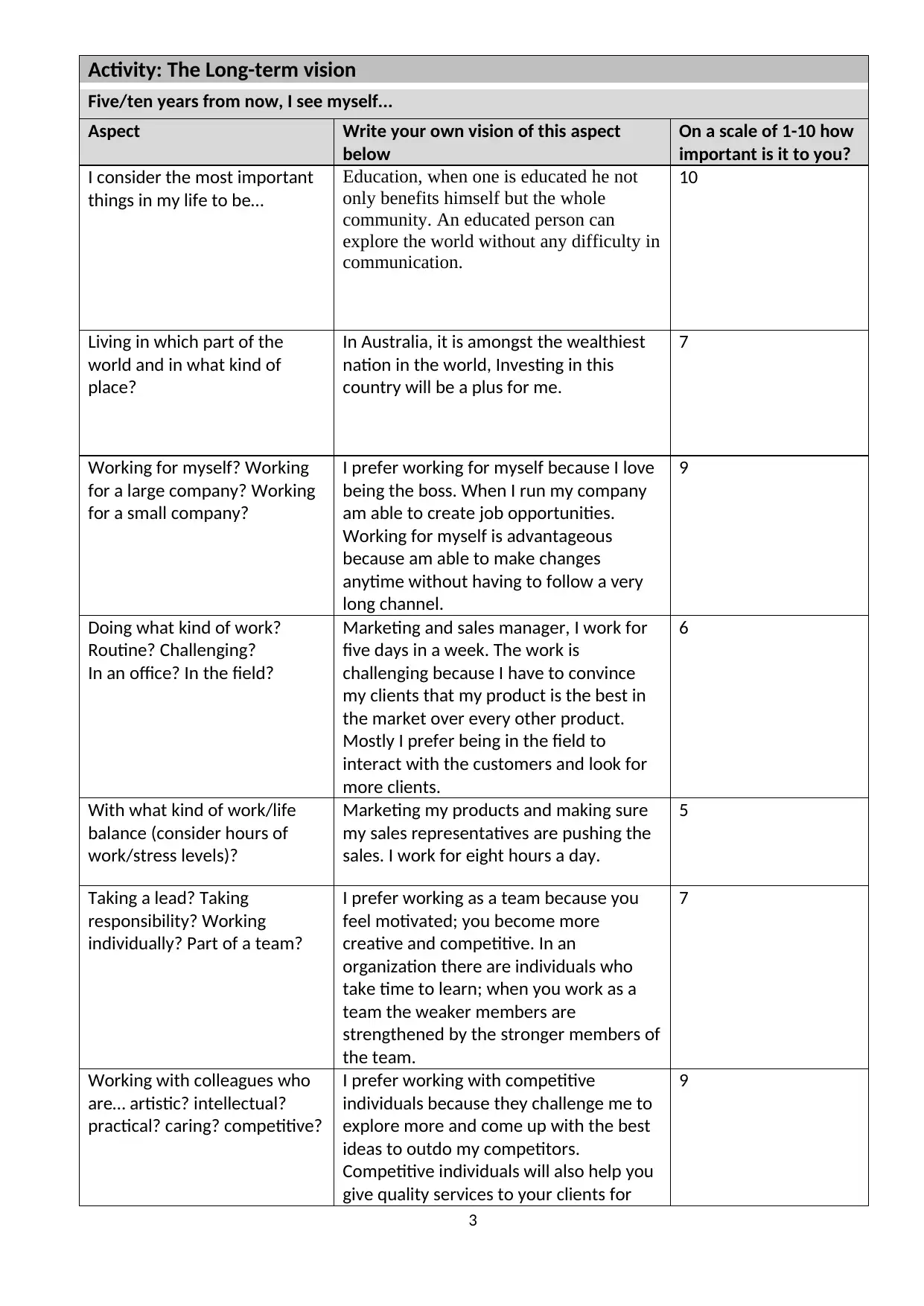
Activity: The Long-term vision
Five/ten years from now, I see myself...
Aspect Write your own vision of this aspect
below
On a scale of 1-10 how
important is it to you?
I consider the most important
things in my life to be…
Education, when one is educated he not
only benefits himself but the whole
community. An educated person can
explore the world without any difficulty in
communication.
10
Living in which part of the
world and in what kind of
place?
In Australia, it is amongst the wealthiest
nation in the world, Investing in this
country will be a plus for me.
7
Working for myself? Working
for a large company? Working
for a small company?
I prefer working for myself because I love
being the boss. When I run my company
am able to create job opportunities.
Working for myself is advantageous
because am able to make changes
anytime without having to follow a very
long channel.
9
Doing what kind of work?
Routine? Challenging?
In an office? In the field?
Marketing and sales manager, I work for
five days in a week. The work is
challenging because I have to convince
my clients that my product is the best in
the market over every other product.
Mostly I prefer being in the field to
interact with the customers and look for
more clients.
6
With what kind of work/life
balance (consider hours of
work/stress levels)?
Marketing my products and making sure
my sales representatives are pushing the
sales. I work for eight hours a day.
5
Taking a lead? Taking
responsibility? Working
individually? Part of a team?
I prefer working as a team because you
feel motivated; you become more
creative and competitive. In an
organization there are individuals who
take time to learn; when you work as a
team the weaker members are
strengthened by the stronger members of
the team.
7
Working with colleagues who
are… artistic? intellectual?
practical? caring? competitive?
I prefer working with competitive
individuals because they challenge me to
explore more and come up with the best
ideas to outdo my competitors.
Competitive individuals will also help you
give quality services to your clients for
9
3
Five/ten years from now, I see myself...
Aspect Write your own vision of this aspect
below
On a scale of 1-10 how
important is it to you?
I consider the most important
things in my life to be…
Education, when one is educated he not
only benefits himself but the whole
community. An educated person can
explore the world without any difficulty in
communication.
10
Living in which part of the
world and in what kind of
place?
In Australia, it is amongst the wealthiest
nation in the world, Investing in this
country will be a plus for me.
7
Working for myself? Working
for a large company? Working
for a small company?
I prefer working for myself because I love
being the boss. When I run my company
am able to create job opportunities.
Working for myself is advantageous
because am able to make changes
anytime without having to follow a very
long channel.
9
Doing what kind of work?
Routine? Challenging?
In an office? In the field?
Marketing and sales manager, I work for
five days in a week. The work is
challenging because I have to convince
my clients that my product is the best in
the market over every other product.
Mostly I prefer being in the field to
interact with the customers and look for
more clients.
6
With what kind of work/life
balance (consider hours of
work/stress levels)?
Marketing my products and making sure
my sales representatives are pushing the
sales. I work for eight hours a day.
5
Taking a lead? Taking
responsibility? Working
individually? Part of a team?
I prefer working as a team because you
feel motivated; you become more
creative and competitive. In an
organization there are individuals who
take time to learn; when you work as a
team the weaker members are
strengthened by the stronger members of
the team.
7
Working with colleagues who
are… artistic? intellectual?
practical? caring? competitive?
I prefer working with competitive
individuals because they challenge me to
explore more and come up with the best
ideas to outdo my competitors.
Competitive individuals will also help you
give quality services to your clients for
9
3
⊘ This is a preview!⊘
Do you want full access?
Subscribe today to unlock all pages.

Trusted by 1+ million students worldwide
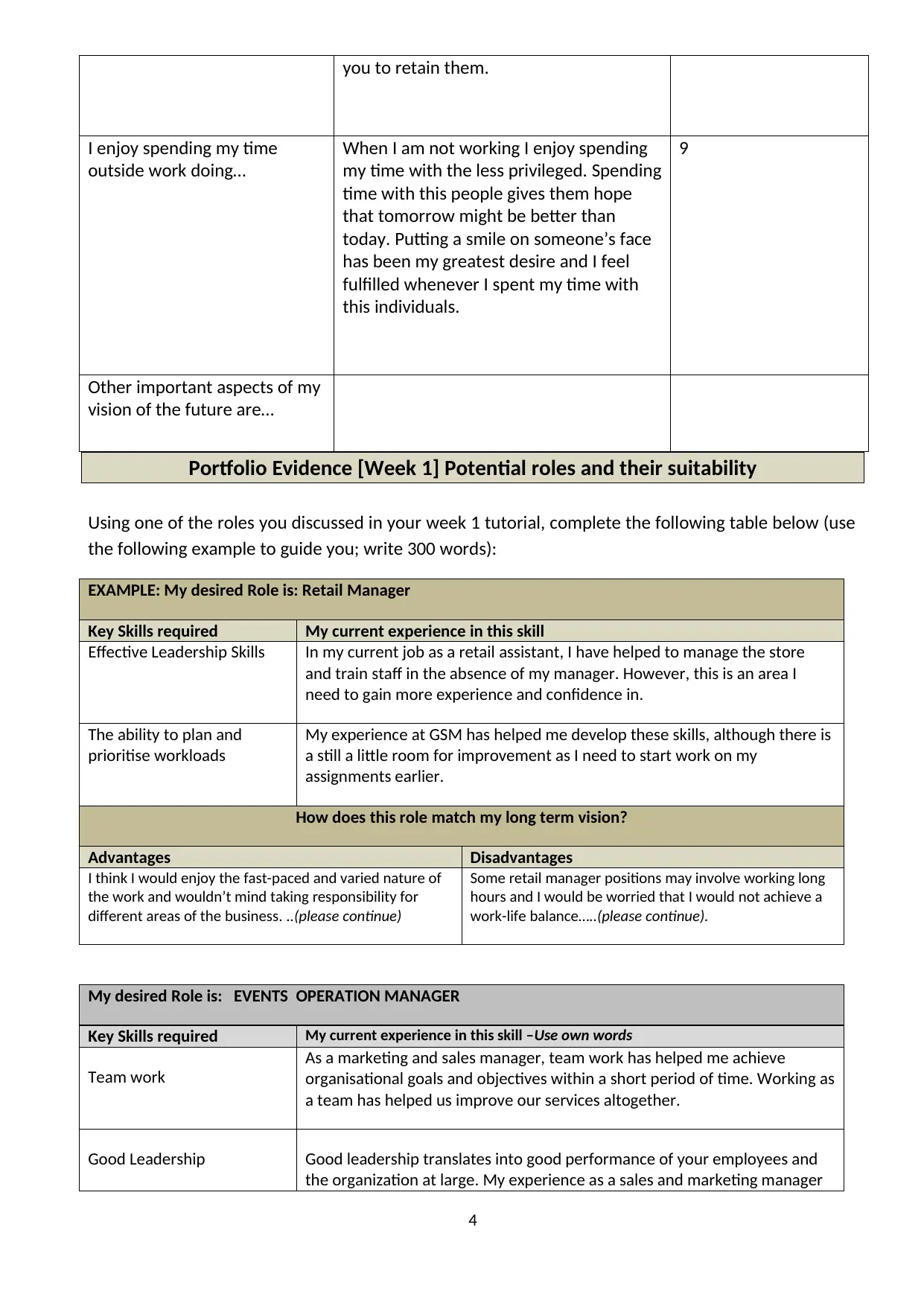
you to retain them.
I enjoy spending my time
outside work doing…
When I am not working I enjoy spending
my time with the less privileged. Spending
time with this people gives them hope
that tomorrow might be better than
today. Putting a smile on someone’s face
has been my greatest desire and I feel
fulfilled whenever I spent my time with
this individuals.
9
Other important aspects of my
vision of the future are…
Portfolio Evidence [Week 1] Potential roles and their suitability
Using one of the roles you discussed in your week 1 tutorial, complete the following table below (use
the following example to guide you; write 300 words):
EXAMPLE: My desired Role is: Retail Manager
Key Skills required My current experience in this skill
Effective Leadership Skills In my current job as a retail assistant, I have helped to manage the store
and train staff in the absence of my manager. However, this is an area I
need to gain more experience and confidence in.
The ability to plan and
prioritise workloads
My experience at GSM has helped me develop these skills, although there is
a still a little room for improvement as I need to start work on my
assignments earlier.
How does this role match my long term vision?
Advantages Disadvantages
I think I would enjoy the fast-paced and varied nature of
the work and wouldn’t mind taking responsibility for
different areas of the business. ..(please continue)
Some retail manager positions may involve working long
hours and I would be worried that I would not achieve a
work-life balance…..(please continue).
My desired Role is: EVENTS OPERATION MANAGER
Key Skills required My current experience in this skill –Use own words
Team work
As a marketing and sales manager, team work has helped me achieve
organisational goals and objectives within a short period of time. Working as
a team has helped us improve our services altogether.
Good Leadership Good leadership translates into good performance of your employees and
the organization at large. My experience as a sales and marketing manager
4
I enjoy spending my time
outside work doing…
When I am not working I enjoy spending
my time with the less privileged. Spending
time with this people gives them hope
that tomorrow might be better than
today. Putting a smile on someone’s face
has been my greatest desire and I feel
fulfilled whenever I spent my time with
this individuals.
9
Other important aspects of my
vision of the future are…
Portfolio Evidence [Week 1] Potential roles and their suitability
Using one of the roles you discussed in your week 1 tutorial, complete the following table below (use
the following example to guide you; write 300 words):
EXAMPLE: My desired Role is: Retail Manager
Key Skills required My current experience in this skill
Effective Leadership Skills In my current job as a retail assistant, I have helped to manage the store
and train staff in the absence of my manager. However, this is an area I
need to gain more experience and confidence in.
The ability to plan and
prioritise workloads
My experience at GSM has helped me develop these skills, although there is
a still a little room for improvement as I need to start work on my
assignments earlier.
How does this role match my long term vision?
Advantages Disadvantages
I think I would enjoy the fast-paced and varied nature of
the work and wouldn’t mind taking responsibility for
different areas of the business. ..(please continue)
Some retail manager positions may involve working long
hours and I would be worried that I would not achieve a
work-life balance…..(please continue).
My desired Role is: EVENTS OPERATION MANAGER
Key Skills required My current experience in this skill –Use own words
Team work
As a marketing and sales manager, team work has helped me achieve
organisational goals and objectives within a short period of time. Working as
a team has helped us improve our services altogether.
Good Leadership Good leadership translates into good performance of your employees and
the organization at large. My experience as a sales and marketing manager
4
Paraphrase This Document
Need a fresh take? Get an instant paraphrase of this document with our AI Paraphraser
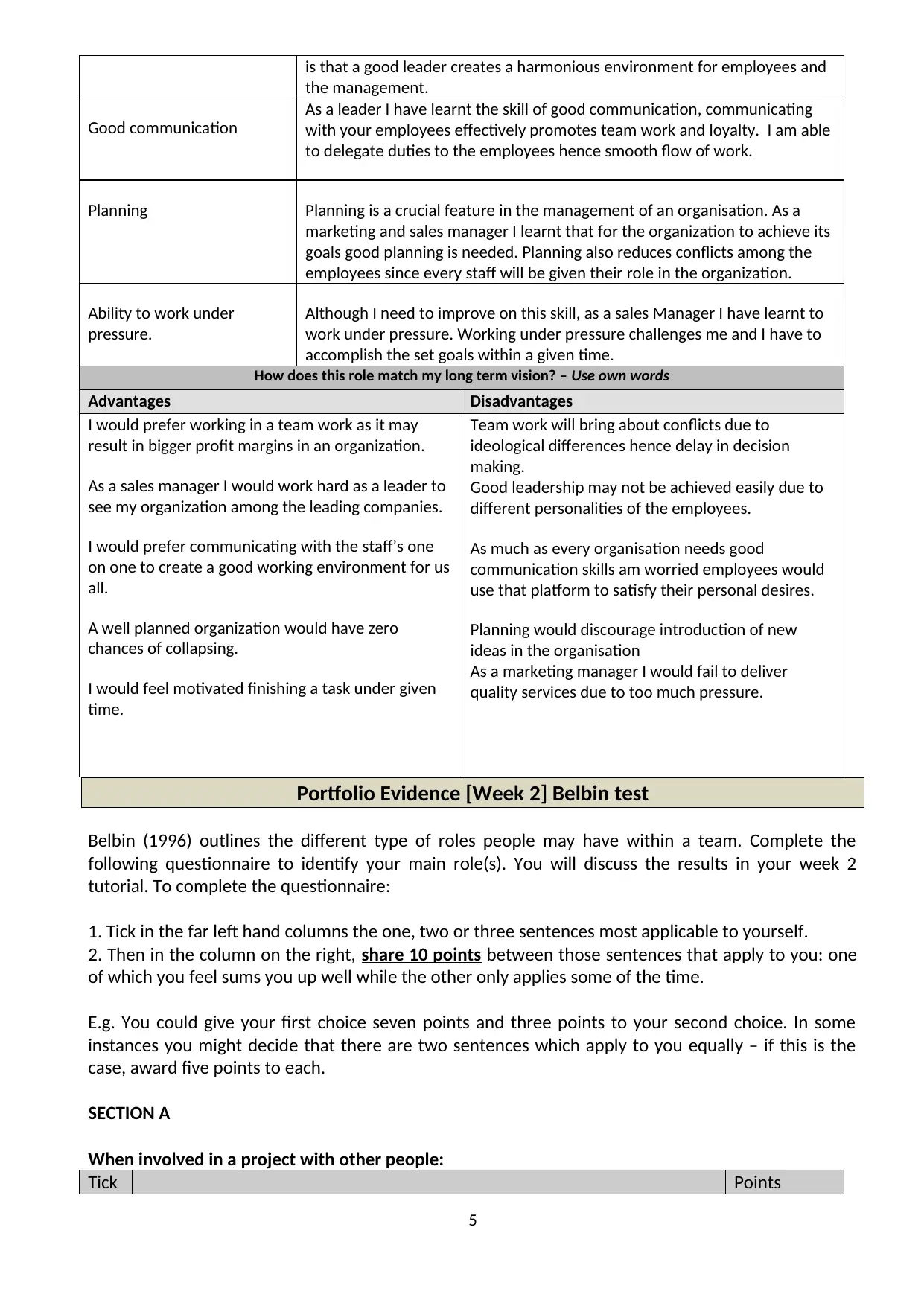
is that a good leader creates a harmonious environment for employees and
the management.
Good communication
As a leader I have learnt the skill of good communication, communicating
with your employees effectively promotes team work and loyalty. I am able
to delegate duties to the employees hence smooth flow of work.
Planning Planning is a crucial feature in the management of an organisation. As a
marketing and sales manager I learnt that for the organization to achieve its
goals good planning is needed. Planning also reduces conflicts among the
employees since every staff will be given their role in the organization.
Ability to work under
pressure.
Although I need to improve on this skill, as a sales Manager I have learnt to
work under pressure. Working under pressure challenges me and I have to
accomplish the set goals within a given time.
How does this role match my long term vision? – Use own words
Advantages Disadvantages
I would prefer working in a team work as it may
result in bigger profit margins in an organization.
As a sales manager I would work hard as a leader to
see my organization among the leading companies.
I would prefer communicating with the staff’s one
on one to create a good working environment for us
all.
A well planned organization would have zero
chances of collapsing.
I would feel motivated finishing a task under given
time.
Team work will bring about conflicts due to
ideological differences hence delay in decision
making.
Good leadership may not be achieved easily due to
different personalities of the employees.
As much as every organisation needs good
communication skills am worried employees would
use that platform to satisfy their personal desires.
Planning would discourage introduction of new
ideas in the organisation
As a marketing manager I would fail to deliver
quality services due to too much pressure.
Portfolio Evidence [Week 2] Belbin test
Belbin (1996) outlines the different type of roles people may have within a team. Complete the
following questionnaire to identify your main role(s). You will discuss the results in your week 2
tutorial. To complete the questionnaire:
1. Tick in the far left hand columns the one, two or three sentences most applicable to yourself.
2. Then in the column on the right, share 10 points between those sentences that apply to you: one
of which you feel sums you up well while the other only applies some of the time.
E.g. You could give your first choice seven points and three points to your second choice. In some
instances you might decide that there are two sentences which apply to you equally – if this is the
case, award five points to each.
SECTION A
When involved in a project with other people:
Tick Points
5
the management.
Good communication
As a leader I have learnt the skill of good communication, communicating
with your employees effectively promotes team work and loyalty. I am able
to delegate duties to the employees hence smooth flow of work.
Planning Planning is a crucial feature in the management of an organisation. As a
marketing and sales manager I learnt that for the organization to achieve its
goals good planning is needed. Planning also reduces conflicts among the
employees since every staff will be given their role in the organization.
Ability to work under
pressure.
Although I need to improve on this skill, as a sales Manager I have learnt to
work under pressure. Working under pressure challenges me and I have to
accomplish the set goals within a given time.
How does this role match my long term vision? – Use own words
Advantages Disadvantages
I would prefer working in a team work as it may
result in bigger profit margins in an organization.
As a sales manager I would work hard as a leader to
see my organization among the leading companies.
I would prefer communicating with the staff’s one
on one to create a good working environment for us
all.
A well planned organization would have zero
chances of collapsing.
I would feel motivated finishing a task under given
time.
Team work will bring about conflicts due to
ideological differences hence delay in decision
making.
Good leadership may not be achieved easily due to
different personalities of the employees.
As much as every organisation needs good
communication skills am worried employees would
use that platform to satisfy their personal desires.
Planning would discourage introduction of new
ideas in the organisation
As a marketing manager I would fail to deliver
quality services due to too much pressure.
Portfolio Evidence [Week 2] Belbin test
Belbin (1996) outlines the different type of roles people may have within a team. Complete the
following questionnaire to identify your main role(s). You will discuss the results in your week 2
tutorial. To complete the questionnaire:
1. Tick in the far left hand columns the one, two or three sentences most applicable to yourself.
2. Then in the column on the right, share 10 points between those sentences that apply to you: one
of which you feel sums you up well while the other only applies some of the time.
E.g. You could give your first choice seven points and three points to your second choice. In some
instances you might decide that there are two sentences which apply to you equally – if this is the
case, award five points to each.
SECTION A
When involved in a project with other people:
Tick Points
5
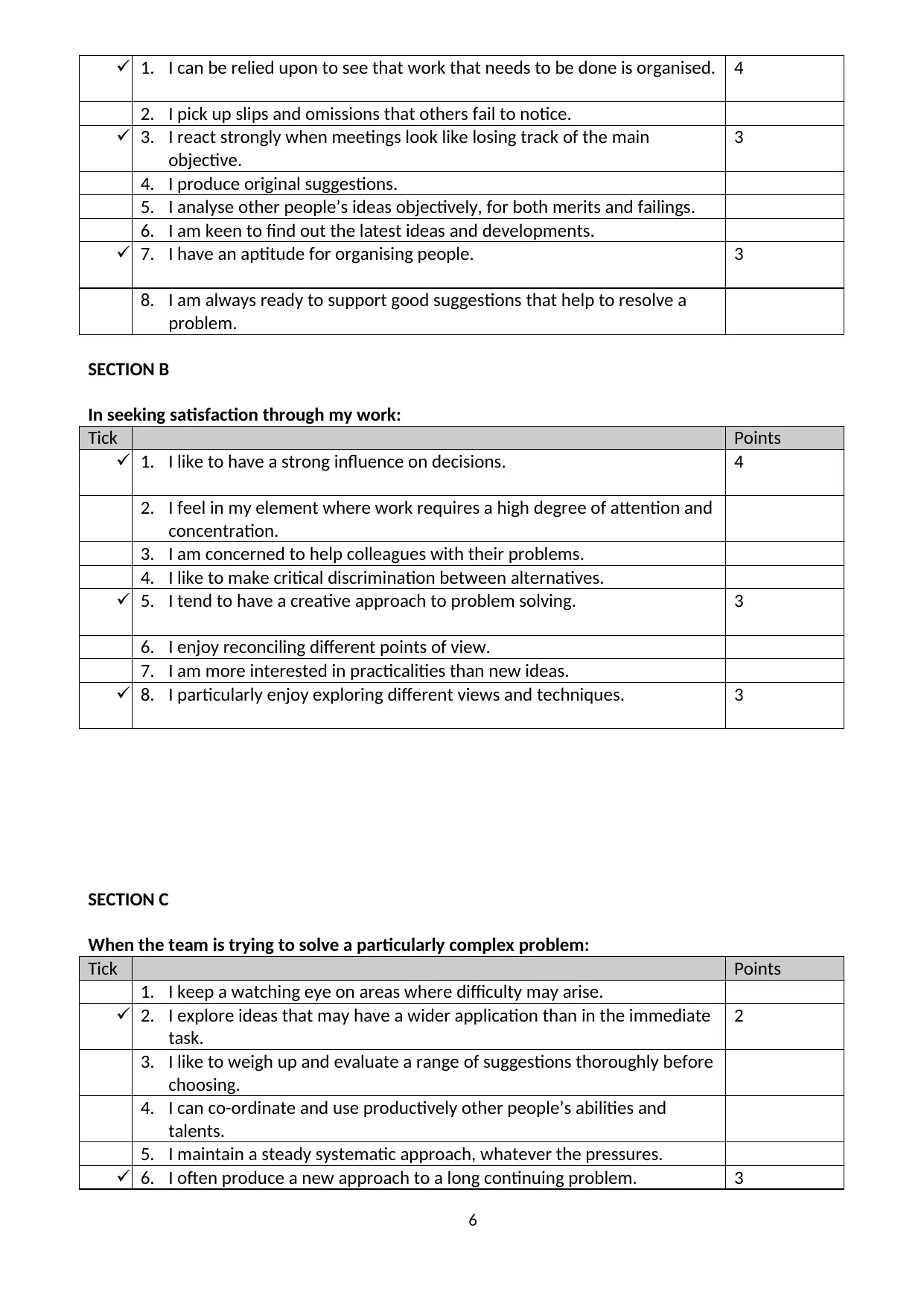
1. I can be relied upon to see that work that needs to be done is organised. 4
2. I pick up slips and omissions that others fail to notice.
3. I react strongly when meetings look like losing track of the main
objective.
3
4. I produce original suggestions.
5. I analyse other people’s ideas objectively, for both merits and failings.
6. I am keen to find out the latest ideas and developments.
7. I have an aptitude for organising people. 3
8. I am always ready to support good suggestions that help to resolve a
problem.
SECTION B
In seeking satisfaction through my work:
Tick Points
1. I like to have a strong influence on decisions. 4
2. I feel in my element where work requires a high degree of attention and
concentration.
3. I am concerned to help colleagues with their problems.
4. I like to make critical discrimination between alternatives.
5. I tend to have a creative approach to problem solving. 3
6. I enjoy reconciling different points of view.
7. I am more interested in practicalities than new ideas.
8. I particularly enjoy exploring different views and techniques. 3
SECTION C
When the team is trying to solve a particularly complex problem:
Tick Points
1. I keep a watching eye on areas where difficulty may arise.
2. I explore ideas that may have a wider application than in the immediate
task.
2
3. I like to weigh up and evaluate a range of suggestions thoroughly before
choosing.
4. I can co-ordinate and use productively other people’s abilities and
talents.
5. I maintain a steady systematic approach, whatever the pressures.
6. I often produce a new approach to a long continuing problem. 3
6
2. I pick up slips and omissions that others fail to notice.
3. I react strongly when meetings look like losing track of the main
objective.
3
4. I produce original suggestions.
5. I analyse other people’s ideas objectively, for both merits and failings.
6. I am keen to find out the latest ideas and developments.
7. I have an aptitude for organising people. 3
8. I am always ready to support good suggestions that help to resolve a
problem.
SECTION B
In seeking satisfaction through my work:
Tick Points
1. I like to have a strong influence on decisions. 4
2. I feel in my element where work requires a high degree of attention and
concentration.
3. I am concerned to help colleagues with their problems.
4. I like to make critical discrimination between alternatives.
5. I tend to have a creative approach to problem solving. 3
6. I enjoy reconciling different points of view.
7. I am more interested in practicalities than new ideas.
8. I particularly enjoy exploring different views and techniques. 3
SECTION C
When the team is trying to solve a particularly complex problem:
Tick Points
1. I keep a watching eye on areas where difficulty may arise.
2. I explore ideas that may have a wider application than in the immediate
task.
2
3. I like to weigh up and evaluate a range of suggestions thoroughly before
choosing.
4. I can co-ordinate and use productively other people’s abilities and
talents.
5. I maintain a steady systematic approach, whatever the pressures.
6. I often produce a new approach to a long continuing problem. 3
6
⊘ This is a preview!⊘
Do you want full access?
Subscribe today to unlock all pages.

Trusted by 1+ million students worldwide
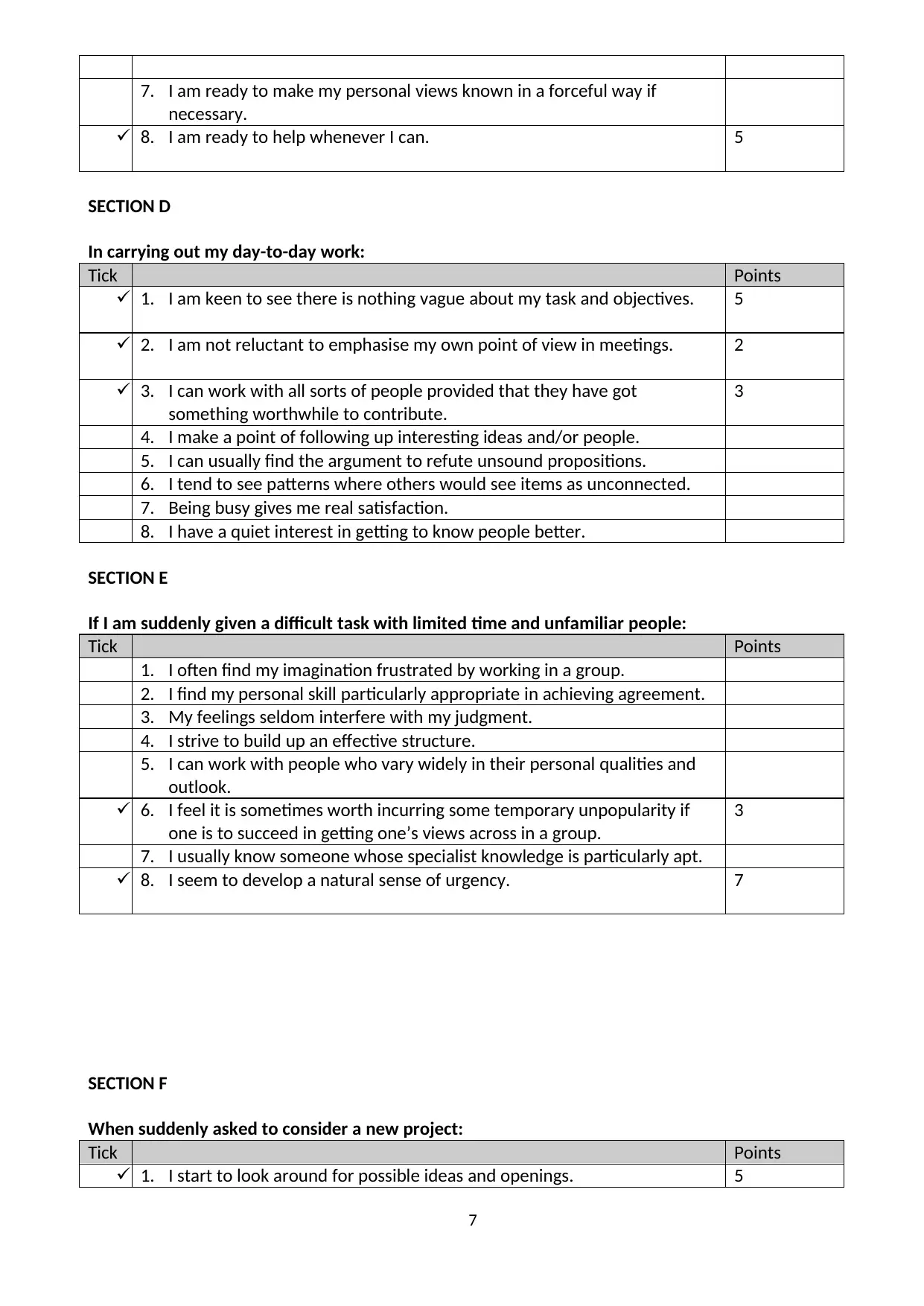
7. I am ready to make my personal views known in a forceful way if
necessary.
8. I am ready to help whenever I can. 5
SECTION D
In carrying out my day-to-day work:
Tick Points
1. I am keen to see there is nothing vague about my task and objectives. 5
2. I am not reluctant to emphasise my own point of view in meetings. 2
3. I can work with all sorts of people provided that they have got
something worthwhile to contribute.
3
4. I make a point of following up interesting ideas and/or people.
5. I can usually find the argument to refute unsound propositions.
6. I tend to see patterns where others would see items as unconnected.
7. Being busy gives me real satisfaction.
8. I have a quiet interest in getting to know people better.
SECTION E
If I am suddenly given a difficult task with limited time and unfamiliar people:
Tick Points
1. I often find my imagination frustrated by working in a group.
2. I find my personal skill particularly appropriate in achieving agreement.
3. My feelings seldom interfere with my judgment.
4. I strive to build up an effective structure.
5. I can work with people who vary widely in their personal qualities and
outlook.
6. I feel it is sometimes worth incurring some temporary unpopularity if
one is to succeed in getting one’s views across in a group.
3
7. I usually know someone whose specialist knowledge is particularly apt.
8. I seem to develop a natural sense of urgency. 7
SECTION F
When suddenly asked to consider a new project:
Tick Points
1. I start to look around for possible ideas and openings. 5
7
necessary.
8. I am ready to help whenever I can. 5
SECTION D
In carrying out my day-to-day work:
Tick Points
1. I am keen to see there is nothing vague about my task and objectives. 5
2. I am not reluctant to emphasise my own point of view in meetings. 2
3. I can work with all sorts of people provided that they have got
something worthwhile to contribute.
3
4. I make a point of following up interesting ideas and/or people.
5. I can usually find the argument to refute unsound propositions.
6. I tend to see patterns where others would see items as unconnected.
7. Being busy gives me real satisfaction.
8. I have a quiet interest in getting to know people better.
SECTION E
If I am suddenly given a difficult task with limited time and unfamiliar people:
Tick Points
1. I often find my imagination frustrated by working in a group.
2. I find my personal skill particularly appropriate in achieving agreement.
3. My feelings seldom interfere with my judgment.
4. I strive to build up an effective structure.
5. I can work with people who vary widely in their personal qualities and
outlook.
6. I feel it is sometimes worth incurring some temporary unpopularity if
one is to succeed in getting one’s views across in a group.
3
7. I usually know someone whose specialist knowledge is particularly apt.
8. I seem to develop a natural sense of urgency. 7
SECTION F
When suddenly asked to consider a new project:
Tick Points
1. I start to look around for possible ideas and openings. 5
7
Paraphrase This Document
Need a fresh take? Get an instant paraphrase of this document with our AI Paraphraser
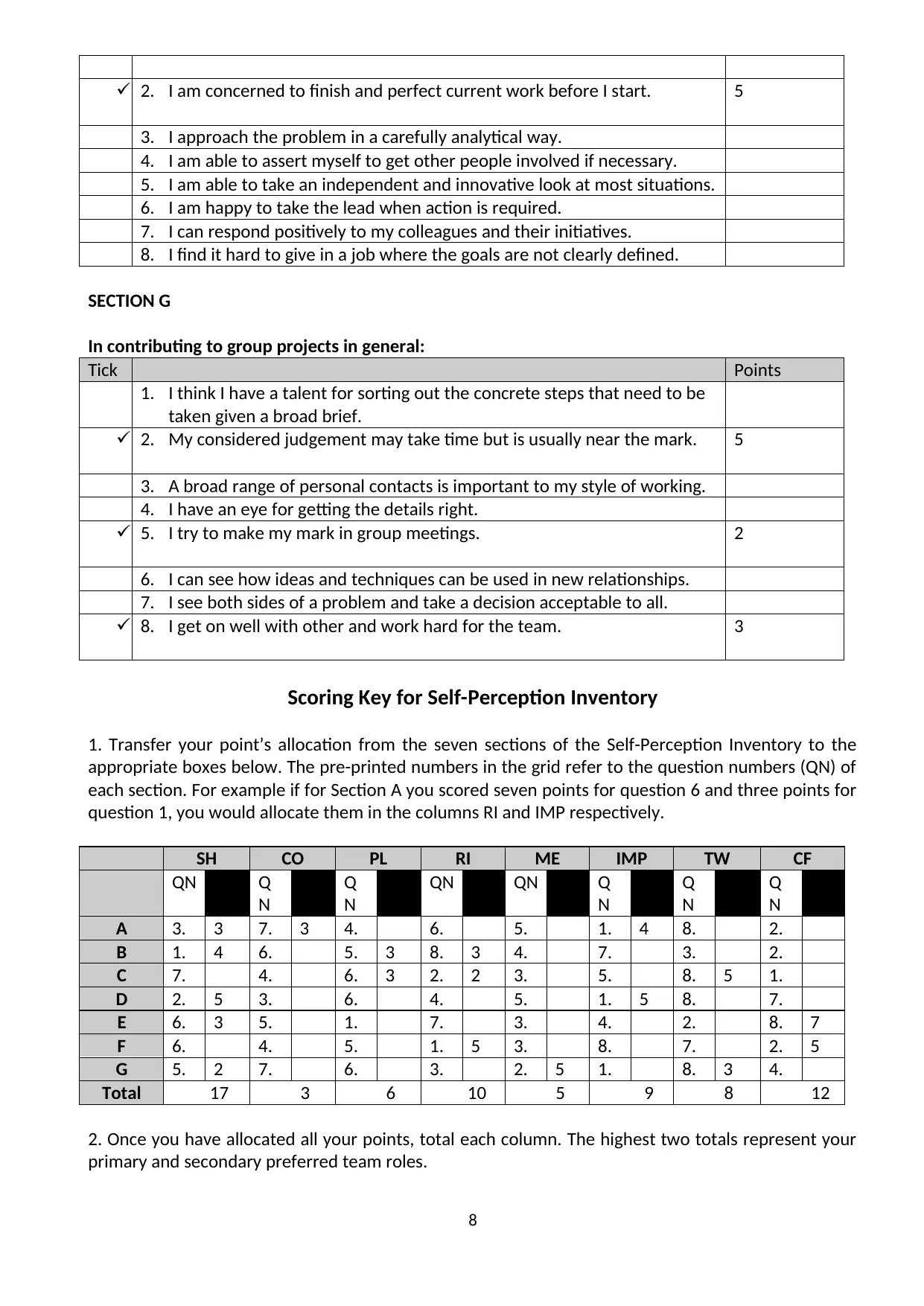
2. I am concerned to finish and perfect current work before I start. 5
3. I approach the problem in a carefully analytical way.
4. I am able to assert myself to get other people involved if necessary.
5. I am able to take an independent and innovative look at most situations.
6. I am happy to take the lead when action is required.
7. I can respond positively to my colleagues and their initiatives.
8. I find it hard to give in a job where the goals are not clearly defined.
SECTION G
In contributing to group projects in general:
Tick Points
1. I think I have a talent for sorting out the concrete steps that need to be
taken given a broad brief.
2. My considered judgement may take time but is usually near the mark. 5
3. A broad range of personal contacts is important to my style of working.
4. I have an eye for getting the details right.
5. I try to make my mark in group meetings. 2
6. I can see how ideas and techniques can be used in new relationships.
7. I see both sides of a problem and take a decision acceptable to all.
8. I get on well with other and work hard for the team. 3
Scoring Key for Self-Perception Inventory
1. Transfer your point’s allocation from the seven sections of the Self-Perception Inventory to the
appropriate boxes below. The pre-printed numbers in the grid refer to the question numbers (QN) of
each section. For example if for Section A you scored seven points for question 6 and three points for
question 1, you would allocate them in the columns RI and IMP respectively.
SH CO PL RI ME IMP TW CF
QN Q
N
Q
N
QN QN Q
N
Q
N
Q
N
A 3. 3 7. 3 4. 6. 5. 1. 4 8. 2.
B 1. 4 6. 5. 3 8. 3 4. 7. 3. 2.
C 7. 4. 6. 3 2. 2 3. 5. 8. 5 1.
D 2. 5 3. 6. 4. 5. 1. 5 8. 7.
E 6. 3 5. 1. 7. 3. 4. 2. 8. 7
F 6. 4. 5. 1. 5 3. 8. 7. 2. 5
G 5. 2 7. 6. 3. 2. 5 1. 8. 3 4.
Total 17 3 6 10 5 9 8 12
2. Once you have allocated all your points, total each column. The highest two totals represent your
primary and secondary preferred team roles.
8
3. I approach the problem in a carefully analytical way.
4. I am able to assert myself to get other people involved if necessary.
5. I am able to take an independent and innovative look at most situations.
6. I am happy to take the lead when action is required.
7. I can respond positively to my colleagues and their initiatives.
8. I find it hard to give in a job where the goals are not clearly defined.
SECTION G
In contributing to group projects in general:
Tick Points
1. I think I have a talent for sorting out the concrete steps that need to be
taken given a broad brief.
2. My considered judgement may take time but is usually near the mark. 5
3. A broad range of personal contacts is important to my style of working.
4. I have an eye for getting the details right.
5. I try to make my mark in group meetings. 2
6. I can see how ideas and techniques can be used in new relationships.
7. I see both sides of a problem and take a decision acceptable to all.
8. I get on well with other and work hard for the team. 3
Scoring Key for Self-Perception Inventory
1. Transfer your point’s allocation from the seven sections of the Self-Perception Inventory to the
appropriate boxes below. The pre-printed numbers in the grid refer to the question numbers (QN) of
each section. For example if for Section A you scored seven points for question 6 and three points for
question 1, you would allocate them in the columns RI and IMP respectively.
SH CO PL RI ME IMP TW CF
QN Q
N
Q
N
QN QN Q
N
Q
N
Q
N
A 3. 3 7. 3 4. 6. 5. 1. 4 8. 2.
B 1. 4 6. 5. 3 8. 3 4. 7. 3. 2.
C 7. 4. 6. 3 2. 2 3. 5. 8. 5 1.
D 2. 5 3. 6. 4. 5. 1. 5 8. 7.
E 6. 3 5. 1. 7. 3. 4. 2. 8. 7
F 6. 4. 5. 1. 5 3. 8. 7. 2. 5
G 5. 2 7. 6. 3. 2. 5 1. 8. 3 4.
Total 17 3 6 10 5 9 8 12
2. Once you have allocated all your points, total each column. The highest two totals represent your
primary and secondary preferred team roles.
8
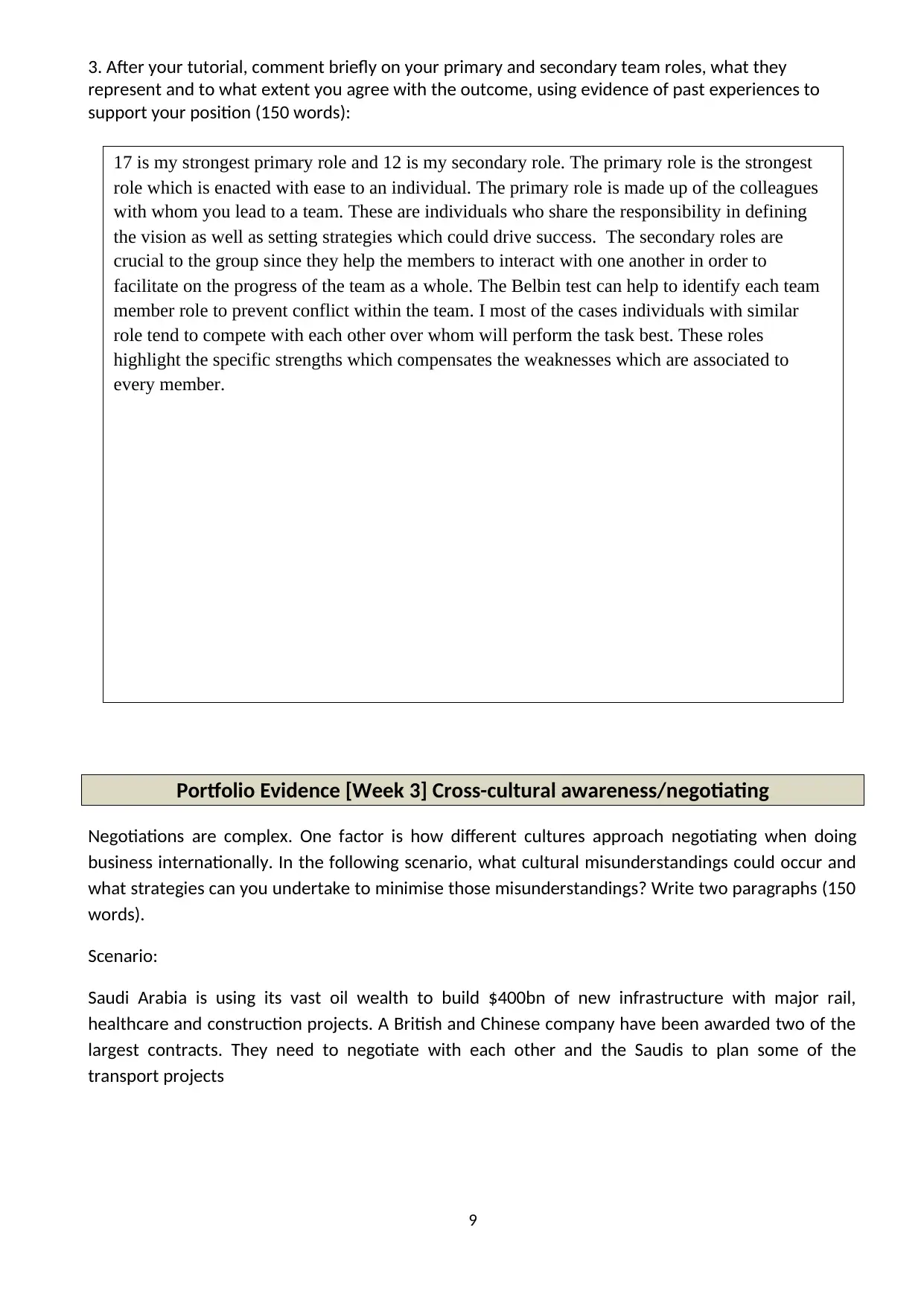
3. After your tutorial, comment briefly on your primary and secondary team roles, what they
represent and to what extent you agree with the outcome, using evidence of past experiences to
support your position (150 words):
Portfolio Evidence [Week 3] Cross-cultural awareness/negotiating
Negotiations are complex. One factor is how different cultures approach negotiating when doing
business internationally. In the following scenario, what cultural misunderstandings could occur and
what strategies can you undertake to minimise those misunderstandings? Write two paragraphs (150
words).
Scenario:
Saudi Arabia is using its vast oil wealth to build $400bn of new infrastructure with major rail,
healthcare and construction projects. A British and Chinese company have been awarded two of the
largest contracts. They need to negotiate with each other and the Saudis to plan some of the
transport projects
9
17 is my strongest primary role and 12 is my secondary role. The primary role is the strongest
role which is enacted with ease to an individual. The primary role is made up of the colleagues
with whom you lead to a team. These are individuals who share the responsibility in defining
the vision as well as setting strategies which could drive success. The secondary roles are
crucial to the group since they help the members to interact with one another in order to
facilitate on the progress of the team as a whole. The Belbin test can help to identify each team
member role to prevent conflict within the team. I most of the cases individuals with similar
role tend to compete with each other over whom will perform the task best. These roles
highlight the specific strengths which compensates the weaknesses which are associated to
every member.
represent and to what extent you agree with the outcome, using evidence of past experiences to
support your position (150 words):
Portfolio Evidence [Week 3] Cross-cultural awareness/negotiating
Negotiations are complex. One factor is how different cultures approach negotiating when doing
business internationally. In the following scenario, what cultural misunderstandings could occur and
what strategies can you undertake to minimise those misunderstandings? Write two paragraphs (150
words).
Scenario:
Saudi Arabia is using its vast oil wealth to build $400bn of new infrastructure with major rail,
healthcare and construction projects. A British and Chinese company have been awarded two of the
largest contracts. They need to negotiate with each other and the Saudis to plan some of the
transport projects
9
17 is my strongest primary role and 12 is my secondary role. The primary role is the strongest
role which is enacted with ease to an individual. The primary role is made up of the colleagues
with whom you lead to a team. These are individuals who share the responsibility in defining
the vision as well as setting strategies which could drive success. The secondary roles are
crucial to the group since they help the members to interact with one another in order to
facilitate on the progress of the team as a whole. The Belbin test can help to identify each team
member role to prevent conflict within the team. I most of the cases individuals with similar
role tend to compete with each other over whom will perform the task best. These roles
highlight the specific strengths which compensates the weaknesses which are associated to
every member.
⊘ This is a preview!⊘
Do you want full access?
Subscribe today to unlock all pages.

Trusted by 1+ million students worldwide
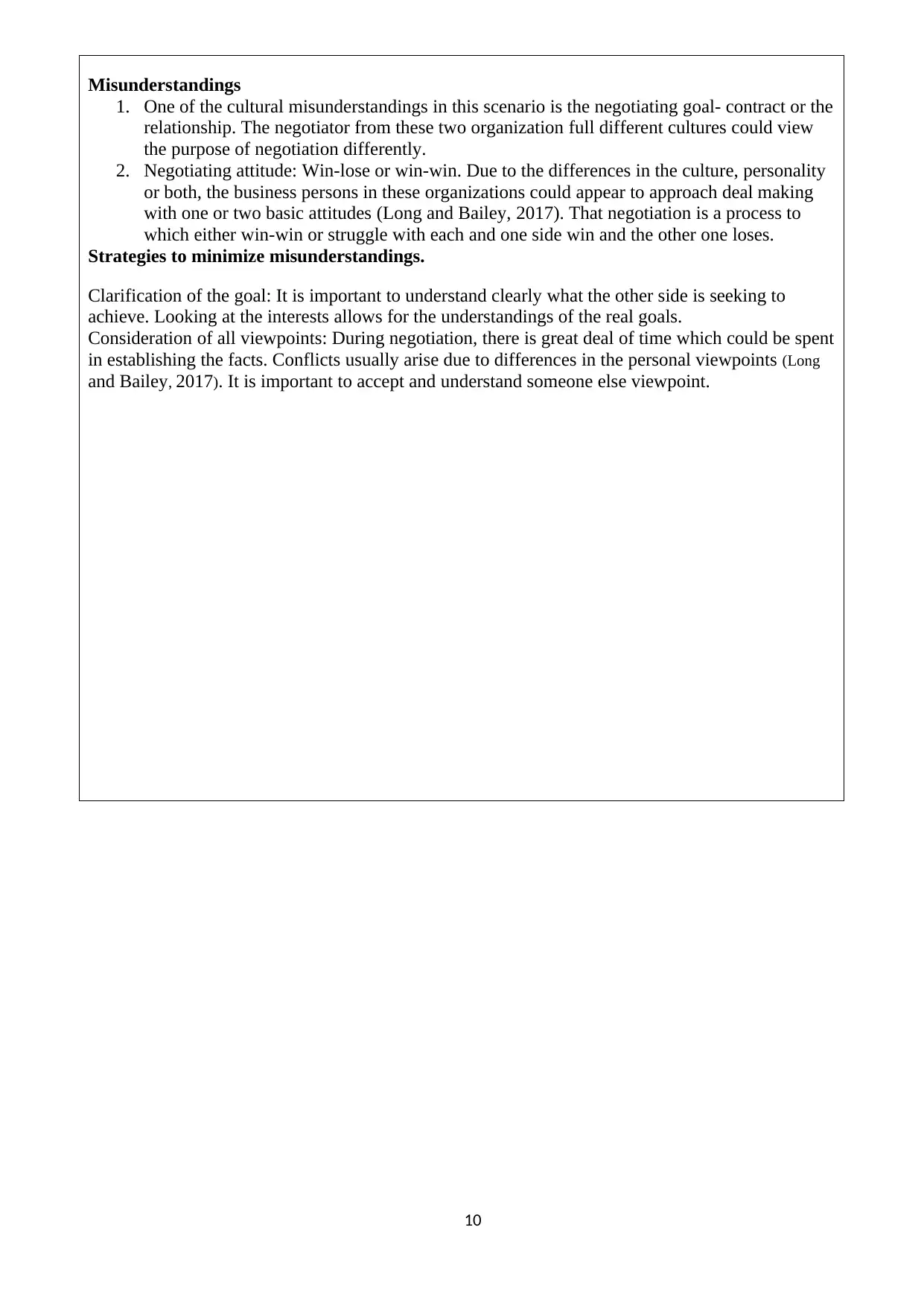
Misunderstandings
1. One of the cultural misunderstandings in this scenario is the negotiating goal- contract or the
relationship. The negotiator from these two organization full different cultures could view
the purpose of negotiation differently.
2. Negotiating attitude: Win-lose or win-win. Due to the differences in the culture, personality
or both, the business persons in these organizations could appear to approach deal making
with one or two basic attitudes (Long and Bailey, 2017). That negotiation is a process to
which either win-win or struggle with each and one side win and the other one loses.
Strategies to minimize misunderstandings.
Clarification of the goal: It is important to understand clearly what the other side is seeking to
achieve. Looking at the interests allows for the understandings of the real goals.
Consideration of all viewpoints: During negotiation, there is great deal of time which could be spent
in establishing the facts. Conflicts usually arise due to differences in the personal viewpoints (Long
and Bailey, 2017). It is important to accept and understand someone else viewpoint.
10
1. One of the cultural misunderstandings in this scenario is the negotiating goal- contract or the
relationship. The negotiator from these two organization full different cultures could view
the purpose of negotiation differently.
2. Negotiating attitude: Win-lose or win-win. Due to the differences in the culture, personality
or both, the business persons in these organizations could appear to approach deal making
with one or two basic attitudes (Long and Bailey, 2017). That negotiation is a process to
which either win-win or struggle with each and one side win and the other one loses.
Strategies to minimize misunderstandings.
Clarification of the goal: It is important to understand clearly what the other side is seeking to
achieve. Looking at the interests allows for the understandings of the real goals.
Consideration of all viewpoints: During negotiation, there is great deal of time which could be spent
in establishing the facts. Conflicts usually arise due to differences in the personal viewpoints (Long
and Bailey, 2017). It is important to accept and understand someone else viewpoint.
10
Paraphrase This Document
Need a fresh take? Get an instant paraphrase of this document with our AI Paraphraser
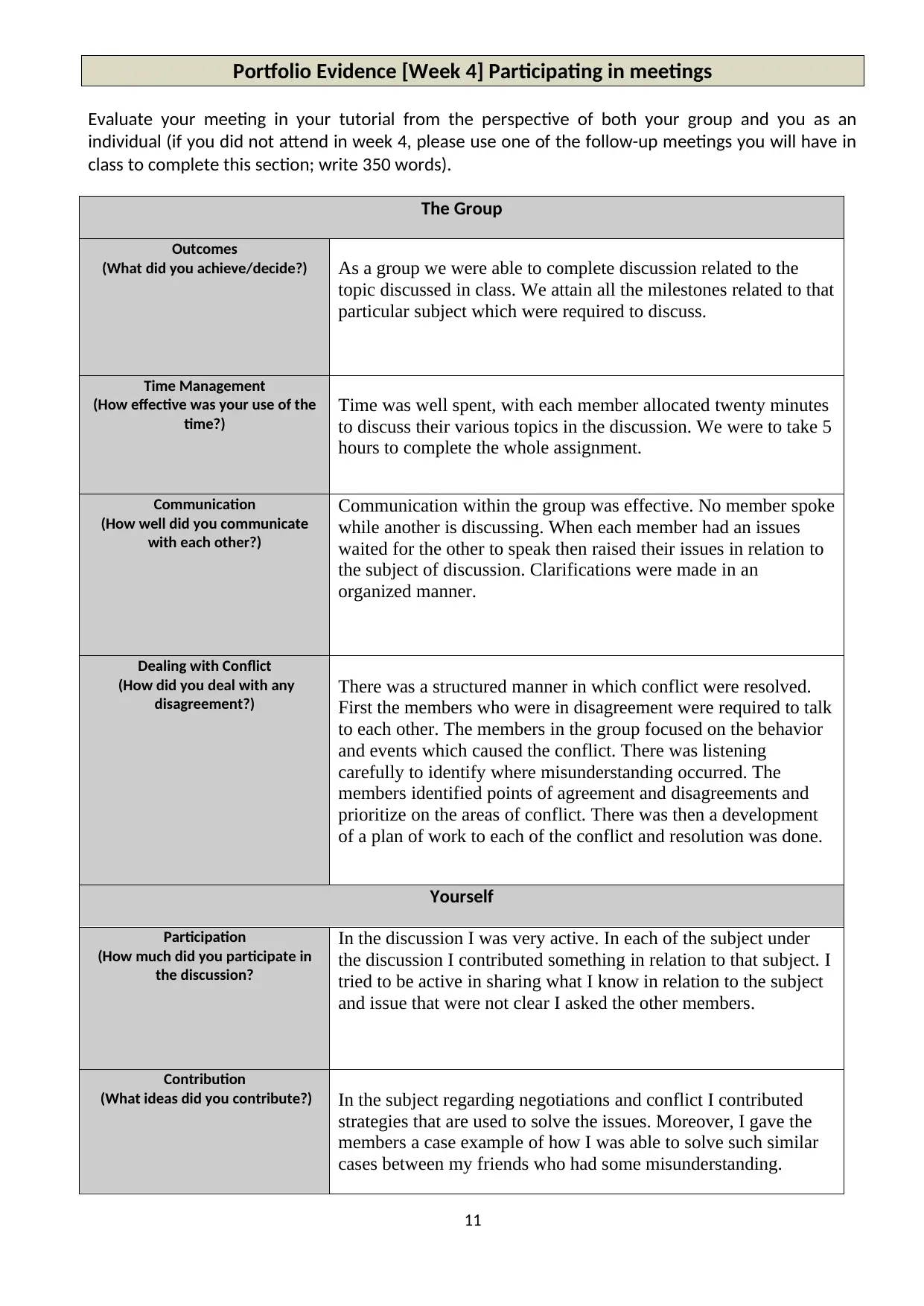
Portfolio Evidence [Week 4] Participating in meetings
Evaluate your meeting in your tutorial from the perspective of both your group and you as an
individual (if you did not attend in week 4, please use one of the follow-up meetings you will have in
class to complete this section; write 350 words).
The Group
Outcomes
(What did you achieve/decide?) As a group we were able to complete discussion related to the
topic discussed in class. We attain all the milestones related to that
particular subject which were required to discuss.
Time Management
(How effective was your use of the
time?)
Time was well spent, with each member allocated twenty minutes
to discuss their various topics in the discussion. We were to take 5
hours to complete the whole assignment.
Communication
(How well did you communicate
with each other?)
Communication within the group was effective. No member spoke
while another is discussing. When each member had an issues
waited for the other to speak then raised their issues in relation to
the subject of discussion. Clarifications were made in an
organized manner.
Dealing with Conflict
(How did you deal with any
disagreement?)
There was a structured manner in which conflict were resolved.
First the members who were in disagreement were required to talk
to each other. The members in the group focused on the behavior
and events which caused the conflict. There was listening
carefully to identify where misunderstanding occurred. The
members identified points of agreement and disagreements and
prioritize on the areas of conflict. There was then a development
of a plan of work to each of the conflict and resolution was done.
Yourself
Participation
(How much did you participate in
the discussion?
In the discussion I was very active. In each of the subject under
the discussion I contributed something in relation to that subject. I
tried to be active in sharing what I know in relation to the subject
and issue that were not clear I asked the other members.
Contribution
(What ideas did you contribute?) In the subject regarding negotiations and conflict I contributed
strategies that are used to solve the issues. Moreover, I gave the
members a case example of how I was able to solve such similar
cases between my friends who had some misunderstanding.
11
Evaluate your meeting in your tutorial from the perspective of both your group and you as an
individual (if you did not attend in week 4, please use one of the follow-up meetings you will have in
class to complete this section; write 350 words).
The Group
Outcomes
(What did you achieve/decide?) As a group we were able to complete discussion related to the
topic discussed in class. We attain all the milestones related to that
particular subject which were required to discuss.
Time Management
(How effective was your use of the
time?)
Time was well spent, with each member allocated twenty minutes
to discuss their various topics in the discussion. We were to take 5
hours to complete the whole assignment.
Communication
(How well did you communicate
with each other?)
Communication within the group was effective. No member spoke
while another is discussing. When each member had an issues
waited for the other to speak then raised their issues in relation to
the subject of discussion. Clarifications were made in an
organized manner.
Dealing with Conflict
(How did you deal with any
disagreement?)
There was a structured manner in which conflict were resolved.
First the members who were in disagreement were required to talk
to each other. The members in the group focused on the behavior
and events which caused the conflict. There was listening
carefully to identify where misunderstanding occurred. The
members identified points of agreement and disagreements and
prioritize on the areas of conflict. There was then a development
of a plan of work to each of the conflict and resolution was done.
Yourself
Participation
(How much did you participate in
the discussion?
In the discussion I was very active. In each of the subject under
the discussion I contributed something in relation to that subject. I
tried to be active in sharing what I know in relation to the subject
and issue that were not clear I asked the other members.
Contribution
(What ideas did you contribute?) In the subject regarding negotiations and conflict I contributed
strategies that are used to solve the issues. Moreover, I gave the
members a case example of how I was able to solve such similar
cases between my friends who had some misunderstanding.
11
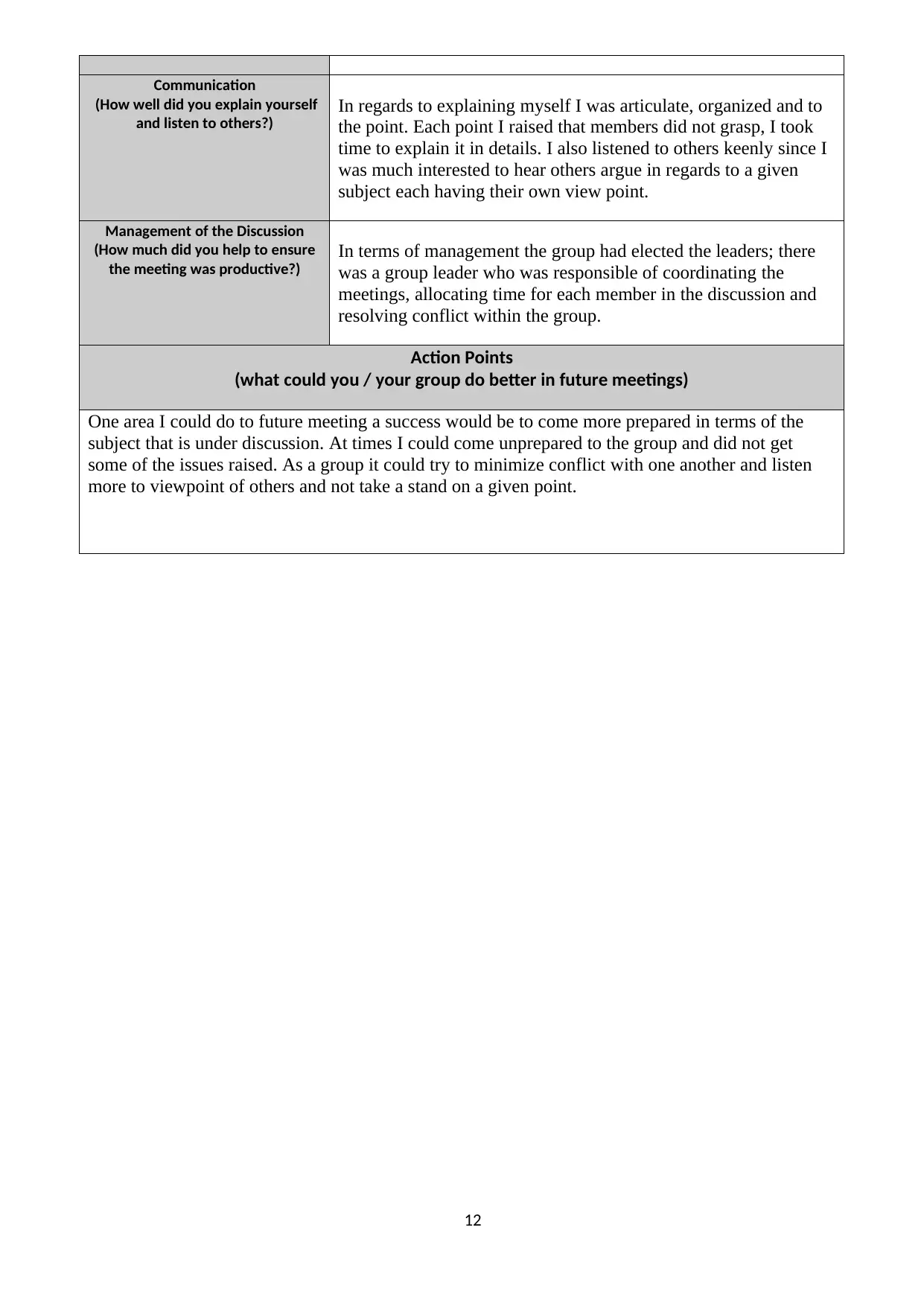
Communication
(How well did you explain yourself
and listen to others?)
In regards to explaining myself I was articulate, organized and to
the point. Each point I raised that members did not grasp, I took
time to explain it in details. I also listened to others keenly since I
was much interested to hear others argue in regards to a given
subject each having their own view point.
Management of the Discussion
(How much did you help to ensure
the meeting was productive?)
In terms of management the group had elected the leaders; there
was a group leader who was responsible of coordinating the
meetings, allocating time for each member in the discussion and
resolving conflict within the group.
Action Points
(what could you / your group do better in future meetings)
One area I could do to future meeting a success would be to come more prepared in terms of the
subject that is under discussion. At times I could come unprepared to the group and did not get
some of the issues raised. As a group it could try to minimize conflict with one another and listen
more to viewpoint of others and not take a stand on a given point.
12
(How well did you explain yourself
and listen to others?)
In regards to explaining myself I was articulate, organized and to
the point. Each point I raised that members did not grasp, I took
time to explain it in details. I also listened to others keenly since I
was much interested to hear others argue in regards to a given
subject each having their own view point.
Management of the Discussion
(How much did you help to ensure
the meeting was productive?)
In terms of management the group had elected the leaders; there
was a group leader who was responsible of coordinating the
meetings, allocating time for each member in the discussion and
resolving conflict within the group.
Action Points
(what could you / your group do better in future meetings)
One area I could do to future meeting a success would be to come more prepared in terms of the
subject that is under discussion. At times I could come unprepared to the group and did not get
some of the issues raised. As a group it could try to minimize conflict with one another and listen
more to viewpoint of others and not take a stand on a given point.
12
⊘ This is a preview!⊘
Do you want full access?
Subscribe today to unlock all pages.

Trusted by 1+ million students worldwide
1 out of 27
Related Documents
Your All-in-One AI-Powered Toolkit for Academic Success.
+13062052269
info@desklib.com
Available 24*7 on WhatsApp / Email
![[object Object]](/_next/static/media/star-bottom.7253800d.svg)
Unlock your academic potential
Copyright © 2020–2025 A2Z Services. All Rights Reserved. Developed and managed by ZUCOL.





